1.nio概念
nio与传统io区别,nio是一个双向管道,管道内没有数据,如果要想从源到目标传递数据需要使用缓冲区.而传统io是单向的管道,管道内直接就是输入或者输出流.nio通道面向缓冲区,io通道面向流.
针对网络通信: nio是


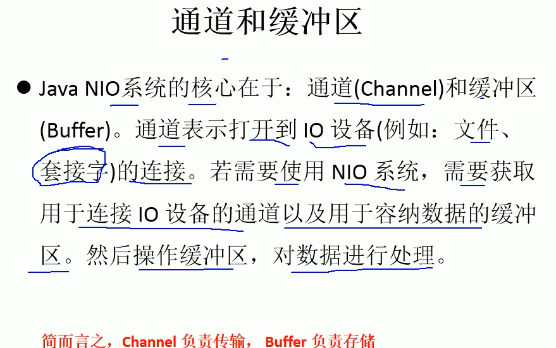
一.缓冲区学习
根据源码,查看核心buffer四个属性.
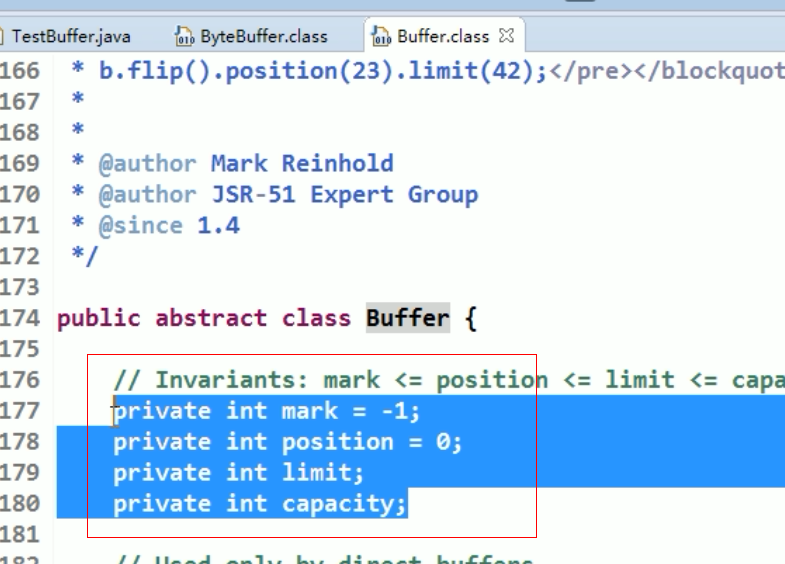
缓冲区读写数据原理

2.直接缓冲区与非直接缓冲区

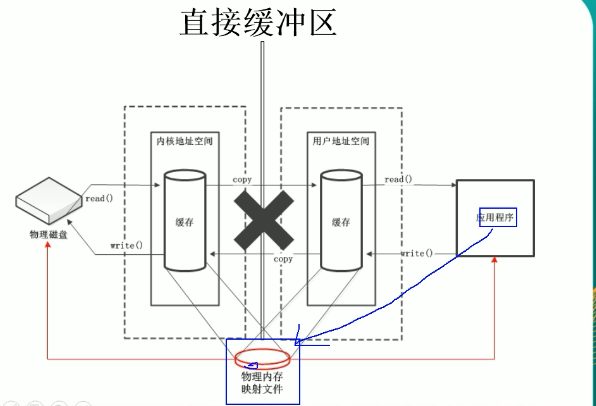

package com.atguigu.nio; import java.nio.ByteBuffer; import org.junit.Test; /* * 一、缓冲区(Buffer):在 Java NIO 中负责数据的存取。缓冲区就是数组。用于存储不同数据类型的数据 * * 根据数据类型不同(boolean 除外),提供了相应类型的缓冲区: * ByteBuffer * CharBuffer * ShortBuffer * IntBuffer * LongBuffer * FloatBuffer * DoubleBuffer * * 上述缓冲区的管理方式几乎一致,通过 allocate() 获取缓冲区 * * 二、缓冲区存取数据的两个核心方法: * put() : 存入数据到缓冲区中 * get() : 获取缓冲区中的数据 * * 三、缓冲区中的四个核心属性: * capacity : 容量,表示缓冲区中最大存储数据的容量。一旦声明不能改变。 * limit : 界限,表示缓冲区中可以操作数据的大小。(limit 后数据不能进行读写) * position : 位置,表示缓冲区中正在操作数据的位置。 * * mark : 标记,表示记录当前 position 的位置。可以通过 reset() 恢复到 mark 的位置 * * 0 <= mark <= position <= limit <= capacity * * 四、直接缓冲区与非直接缓冲区: * 非直接缓冲区:通过 allocate() 方法分配缓冲区,将缓冲区建立在 JVM 的内存中 * 直接缓冲区:通过 allocateDirect() 方法分配直接缓冲区,将缓冲区建立在物理内存中。可以提高效率 */ public class TestBuffer { @Test public void test3(){ //分配直接缓冲区 ByteBuffer buf = ByteBuffer.allocateDirect(1024); System.out.println(buf.isDirect()); } @Test public void test2(){ String str = "abcde"; ByteBuffer buf = ByteBuffer.allocate(1024); buf.put(str.getBytes()); buf.flip(); byte[] dst = new byte[buf.limit()]; buf.get(dst, 0, 2); System.out.println(new String(dst, 0, 2)); System.out.println(buf.position()); //mark() : 标记 buf.mark(); buf.get(dst, 2, 2); System.out.println(new String(dst, 2, 2)); System.out.println(buf.position()); //reset() : 恢复到 mark 的位置 buf.reset(); System.out.println(buf.position()); //判断缓冲区中是否还有剩余数据 if(buf.hasRemaining()){ //获取缓冲区中可以操作的数量 System.out.println(buf.remaining()); } } @Test public void test1(){ String str = "abcde"; //1. 分配一个指定大小的缓冲区 ByteBuffer buf = ByteBuffer.allocate(1024); System.out.println("-----------------allocate()----------------"); System.out.println(buf.position()); System.out.println(buf.limit()); System.out.println(buf.capacity()); //2. 利用 put() 存入数据到缓冲区中 buf.put(str.getBytes()); System.out.println("-----------------put()----------------"); System.out.println(buf.position()); System.out.println(buf.limit()); System.out.println(buf.capacity()); //3. 切换读取数据模式 buf.flip(); System.out.println("-----------------flip()----------------"); System.out.println(buf.position()); System.out.println(buf.limit()); System.out.println(buf.capacity()); //4. 利用 get() 读取缓冲区中的数据 byte[] dst = new byte[buf.limit()]; buf.get(dst); System.out.println(new String(dst, 0, dst.length)); System.out.println("-----------------get()----------------"); System.out.println(buf.position()); System.out.println(buf.limit()); System.out.println(buf.capacity()); //5. rewind() : 可重复读 buf.rewind(); System.out.println("-----------------rewind()----------------"); System.out.println(buf.position()); System.out.println(buf.limit()); System.out.println(buf.capacity()); //6. clear() : 清空缓冲区. 但是缓冲区中的数据依然存在,但是处于“被遗忘”状态 buf.clear(); System.out.println("-----------------clear()----------------"); System.out.println(buf.position()); System.out.println(buf.limit()); System.out.println(buf.capacity()); System.out.println((char)buf.get()); } }
二.通道

三.分散写入和聚集读取
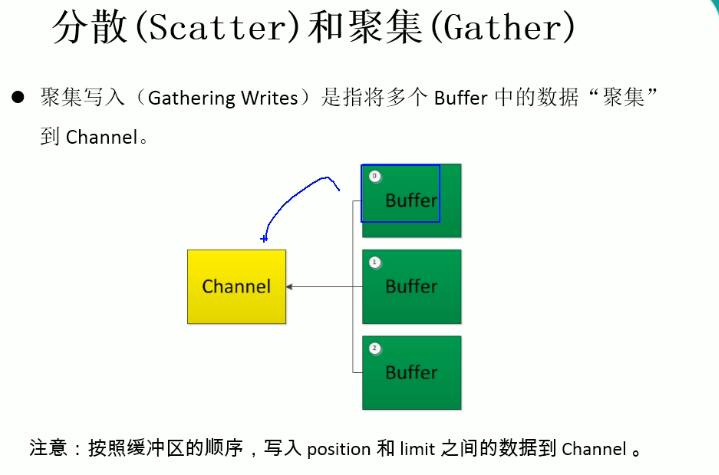

package com.atguigu.nio; import java.io.FileInputStream; import java.io.FileOutputStream; import java.io.IOException; import java.io.RandomAccessFile; import java.nio.ByteBuffer; import java.nio.CharBuffer; import java.nio.MappedByteBuffer; import java.nio.channels.FileChannel; import java.nio.channels.FileChannel.MapMode; import java.nio.charset.CharacterCodingException; import java.nio.charset.Charset; import java.nio.charset.CharsetDecoder; import java.nio.charset.CharsetEncoder; import java.nio.file.Paths; import java.nio.file.StandardOpenOption; import java.util.Map; import java.util.Map.Entry; import java.util.Set; import org.junit.Test; /* * 一、通道(Channel):用于源节点与目标节点的连接。在 Java NIO 中负责缓冲区中数据的传输。Channel 本身不存储数据,因此需要配合缓冲区进行传输。 * * 二、通道的主要实现类 * java.nio.channels.Channel 接口: * |--FileChannel ---对应本地io * |--SocketChannel ---对应网络io * |--ServerSocketChannel ---对应网络io * |--DatagramChannel ---对应网络io * * 三、获取通道 * 1. Java 针对支持通道的类提供了 getChannel() 方法 * 本地 IO: * FileInputStream/FileOutputStream * RandomAccessFile * * 网络IO: * Socket * ServerSocket * DatagramSocket * * 2. 在 JDK 1.7 中的 NIO.2 针对各个通道提供了静态方法 open() * 3. 在 JDK 1.7 中的 NIO.2 的 Files 工具类的 newByteChannel() * * 四、通道之间的数据传输 * transferFrom() * transferTo() * * 五、分散(Scatter)与聚集(Gather) * 分散读取(Scattering Reads):将通道中的数据分散到多个缓冲区中 * 聚集写入(Gathering Writes):将多个缓冲区中的数据聚集到通道中 * * 六、字符集:Charset * 编码:字符串 -> 字节数组 * 解码:字节数组 -> 字符串 * */ public class TestChannel { //字符集 @Test public void test6() throws IOException{ Charset cs1 = Charset.forName("GBK"); //获取编码器 CharsetEncoder ce = cs1.newEncoder(); //获取解码器 CharsetDecoder cd = cs1.newDecoder(); CharBuffer cBuf = CharBuffer.allocate(1024); cBuf.put("尚硅谷威武!"); cBuf.flip(); //编码 ByteBuffer bBuf = ce.encode(cBuf); for (int i = 0; i < 12; i++) { System.out.println(bBuf.get()); } //解码 bBuf.flip(); CharBuffer cBuf2 = cd.decode(bBuf); System.out.println(cBuf2.toString()); System.out.println("------------------------------------------------------"); Charset cs2 = Charset.forName("GBK"); bBuf.flip(); CharBuffer cBuf3 = cs2.decode(bBuf); System.out.println(cBuf3.toString()); } @Test public void test5(){ Map<String, Charset> map = Charset.availableCharsets(); Set<Entry<String, Charset>> set = map.entrySet(); for (Entry<String, Charset> entry : set) { System.out.println(entry.getKey() + "=" + entry.getValue()); } } //分散和聚集 @Test public void test4() throws IOException{ RandomAccessFile raf1 = new RandomAccessFile("1.txt", "rw"); //1. 获取通道 FileChannel channel1 = raf1.getChannel(); //2. 分配指定大小的缓冲区 ByteBuffer buf1 = ByteBuffer.allocate(100); ByteBuffer buf2 = ByteBuffer.allocate(1024); //3. 分散读取 ByteBuffer[] bufs = {buf1, buf2}; channel1.read(bufs); for (ByteBuffer byteBuffer : bufs) { byteBuffer.flip(); } System.out.println(new String(bufs[0].array(), 0, bufs[0].limit())); System.out.println("-----------------"); System.out.println(new String(bufs[1].array(), 0, bufs[1].limit())); //4. 聚集写入 RandomAccessFile raf2 = new RandomAccessFile("2.txt", "rw"); FileChannel channel2 = raf2.getChannel(); channel2.write(bufs); } //通道之间的数据传输(直接缓冲区) @Test public void test3() throws IOException{ FileChannel inChannel = FileChannel.open(Paths.get("d:/1.mkv"), StandardOpenOption.READ); FileChannel outChannel = FileChannel.open(Paths.get("d:/2.mkv"), StandardOpenOption.WRITE, StandardOpenOption.READ, StandardOpenOption.CREATE); // inChannel.transferTo(0, inChannel.size(), outChannel); outChannel.transferFrom(inChannel, 0, inChannel.size()); inChannel.close(); outChannel.close(); } //使用直接缓冲区完成文件的复制(内存映射文件) @Test public void test2() throws IOException{//2127-1902-1777 long start = System.currentTimeMillis(); FileChannel inChannel = FileChannel.open(Paths.get("d:/1.mkv"), StandardOpenOption.READ); FileChannel outChannel = FileChannel.open(Paths.get("d:/2.mkv"), StandardOpenOption.WRITE, StandardOpenOption.READ, StandardOpenOption.CREATE); //内存映射文件 MappedByteBuffer inMappedBuf = inChannel.map(MapMode.READ_ONLY, 0, inChannel.size()); MappedByteBuffer outMappedBuf = outChannel.map(MapMode.READ_WRITE, 0, inChannel.size()); //直接对缓冲区进行数据的读写操作 byte[] dst = new byte[inMappedBuf.limit()]; inMappedBuf.get(dst); outMappedBuf.put(dst); inChannel.close(); outChannel.close(); long end = System.currentTimeMillis(); System.out.println("耗费时间为:" + (end - start)); } //利用通道完成文件的复制(非直接缓冲区) @Test public void test1(){//10874-10953 long start = System.currentTimeMillis(); FileInputStream fis = null; FileOutputStream fos = null; //①获取通道 FileChannel inChannel = null; FileChannel outChannel = null; try { fis = new FileInputStream("d:/1.mkv"); fos = new FileOutputStream("d:/2.mkv"); inChannel = fis.getChannel(); outChannel = fos.getChannel(); //②分配指定大小的缓冲区 ByteBuffer buf = ByteBuffer.allocate(1024); //③将通道中的数据存入缓冲区中 while(inChannel.read(buf) != -1){ buf.flip(); //切换读取数据的模式 //④将缓冲区中的数据写入通道中 outChannel.write(buf); buf.clear(); //清空缓冲区 } } catch (IOException e) { e.printStackTrace(); } finally { if(outChannel != null){ try { outChannel.close(); } catch (IOException e) { e.printStackTrace(); } } if(inChannel != null){ try { inChannel.close(); } catch (IOException e) { e.printStackTrace(); } } if(fos != null){ try { fos.close(); } catch (IOException e) { e.printStackTrace(); } } if(fis != null){ try { fis.close(); } catch (IOException e) { e.printStackTrace(); } } } long end = System.currentTimeMillis(); System.out.println("耗费时间为:" + (end - start)); } }
三.NIO阻塞式和非阻塞式网络通信
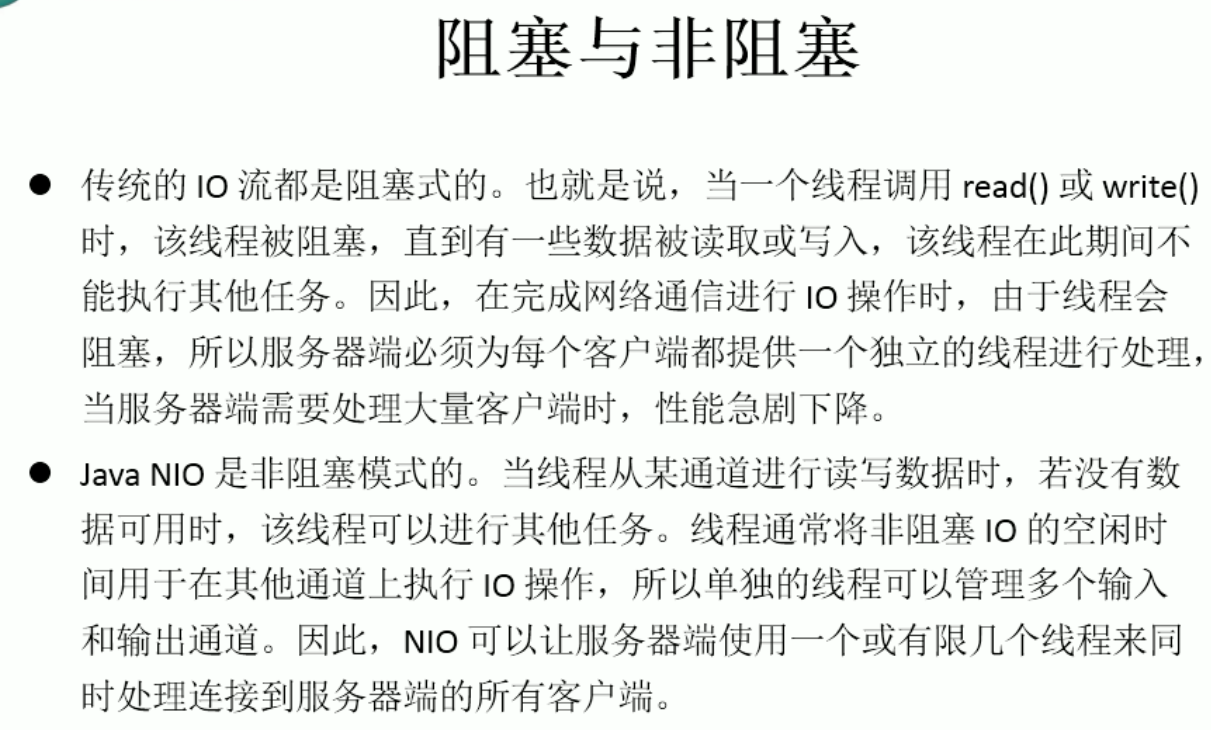
阻塞式
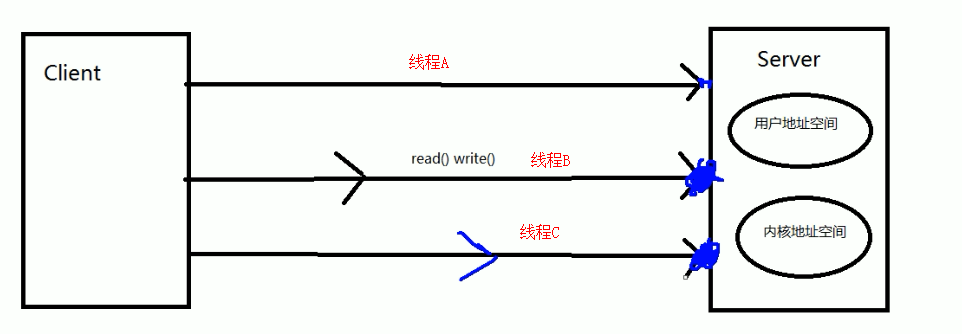
非阻塞式

